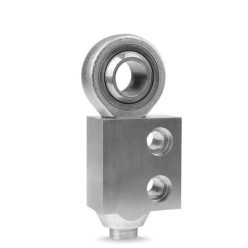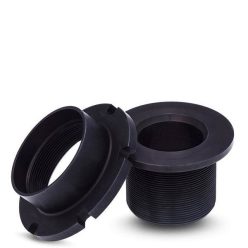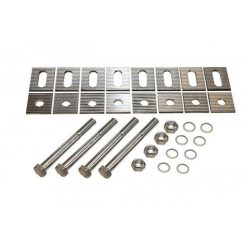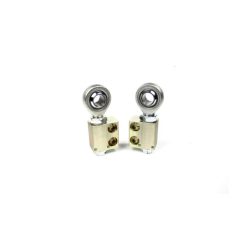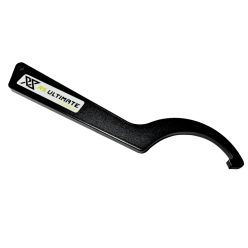The Suspension accessories and installation parts category gathers specialised suspension tools, adjustable alignment kits, solid subframe bushings and brake/suspension mounting hardware for performance builds. From RS ULTIMATE coilover height adjustment keys through PMC and SWAGIER rear camber/toe solutions to CNC-machined aluminium rear beam and diff bushes and D2 RACING brake line brackets, these components make installation easier and help maintain precise geometry on track, drift and fast-road cars.
Net price: 13 €
Net price: 67 €
Net price: 73 €
Net price: 145 €
Net price: 196 €
Net price: 95 €
Role and Key Benefits
Suspension accessories and installation parts cover all the specialist components that sit around the main springs, dampers and anti-roll bars and make a performance chassis work properly. This includes coilover height adjustment wrenches, rear camber and toe correction kits, solid aluminium subframe and differential bushings, and dedicated mounts and brackets for brake lines and other suspension hardware. Together, they allow you to fine-tune geometry, secure hoses and arms correctly, and extract the full potential from coilovers, big brake kits and uprated tyres on track, drift or time-attack builds.
The range features brands such as PMC, SWAGIER, RS ULTIMATE, ODESA CNC, CNC71, FAT, MTUNING and D2 RACING, many of which focus on BMW platforms and motorsport applications. SWAGIER’s rear alignment solutions for BMW E30/E21/E36, for example, are CNC-milled from S235 steel and supplied with 10.9 grade bolts, providing wide adjustment range and durability proven in drift and rally use. PMC’s solid rear beam bushes for BMW E9x/E8x completely eliminate subframe movement, keeping dynamic alignment consistent under heavy load and reducing stress on the drivetrain.
Alongside these major parts, smaller but essential items like brake line mounting brackets from D2 RACING ensure that braided hoses are properly supported and routed. Without correct brackets and clips, brake lines and cables can chafe, kink or rub on moving components, eventually leading to leaks or failures. With the right accessories, you can build a chassis that not only sits at the right height and camber values but also remains safe, reliable and easy to adjust as conditions or setup requirements change.
Technical Basics
Coilover adjustment wrenches are shaped spanners that match the profiles of threaded spring seat nuts on height-adjustable suspension. The RS ULTIMATE 72–80 mm half-round tooth wrench, for instance, is cut from 6 mm S355 steel, powder-coated and designed to maximise contact area on the adjuster nut. It works with a wide range of threaded suspension brands (KONI, KW, H&R, BILSTEIN, TEIN, MTS, AP and many more), helping prevent damage to the soft alloy collars during height changes.
Rear wheel alignment kits such as SWAGIER’s BMW E30/E21/E36 solution use CNC-milled steel plates and high-strength hardware to provide extra camber and toe range at the rear axle. By repositioning the mounting points, they allow you to dial in more negative camber for drift or stance builds, or to optimise traction on drag-style ¼ mile cars by fine-tuning toe and camber on the drive wheels. The kits are engineered to cope with motorsport abuse, with 10.9 grade bolts and robust plate thickness to avoid deformation.
Solid aluminium bushings for subframes and differentials, such as PMC’s E9x/E8x rear beam bushes, replace flexible rubber mounts with CNC-machined alloy. This completely removes subframe movement relative to the body, ensuring that camber and toe settings remain stable as load builds and releases. While this greatly improves precision and feedback, it also increases NVH levels, making such bushings more suitable for dedicated performance and track cars than for comfort-focused daily drivers.
Small hardware like brake line brackets (for example, the D2 Racing Brake line mounting) is typically made from light but strong steel or aluminium. These parts clamp or locate braided hoses and hard lines at specific points on the chassis and suspension, permitting full travel of arms and struts without stressing the hoses. Correct bracket positioning is critical when fitting aftermarket big brake kits, as OEM mounting points may no longer align with the new caliper and hose routing.
Selection Criteria
When choosing suspension accessories, start with your use case and base chassis. If you often adjust ride height or preload on coilovers, a properly sized adjustment wrench is essential; check the nut diameter range (for example 72–80 mm) and tooth pattern to match your specific coilover system. For alignment kits, always select vehicle-specific solutions designed for your exact platform, such as BMW E30/E36 or E9x, and verify plate design, bolt size and the intended adjustment range before ordering.
When considering solid bushings, realistically assess how much NVH you are willing to accept. A solid rear beam bushing set on an E9x/E8x BMW locks the subframe firmly to the body, giving very precise response but also transmitting more drivetrain and road noise into the cabin. For mixed-use street/track cars, some owners prefer a compromise such as polyurethane, whereas full aluminium bushes are often reserved for track, drift or competition builds. Always confirm that the kit covers all required positions (for example four rear subframe bushes) for your exact model.
For installation hardware like brake line mounts, bolts and clamps, pay careful attention to dimensions, thread pitch and mounting hole spacing. A bracket designed for D2 Racing calipers and hoses will usually offer the most straightforward fit if you are running a D2 big brake kit, while universal pieces may require test-fitting and fabrication. On heavily modified cars with non-standard coilovers, arms and brakes, it is wise to plan accessories as part of the overall suspension design rather than as an afterthought, ideally with input from an experienced workshop.
Installation & Maintenance
Installing suspension accessories such as alignment kits, bushings and brackets is safety critical, so professional fitting is recommended. Alignment kits must be bolted to clean, flat surfaces, and all fasteners torqued to the manufacturer’s specifications using a calibrated torque wrench. After any geometry-related work—such as fitting eccentric plates, arms or solid subframe bushes—a full alignment check is essential to ensure camber, caster and toe are within desired ranges.
When using coilover wrenches, first clean the threads on the damper body and collars to remove dirt and corrosion. Work gradually, avoiding sudden hammer blows that could damage the adjuster nuts or strip their teeth. A thin film of suitable anti-seize or thread lubricant (recommended by the suspension manufacturer) can help keep collars movable in the long term, but avoid contaminating damper seals or brake components.
For small hardware like brake line brackets and clamps, confirm that hoses do not stretch, kink or touch sharp edges throughout the full suspension and steering travel. Periodically inspect brackets and fasteners for loosening or fatigue, especially on cars that see regular track or drift use. With solid bushings and alignment kits, add regular checks for cracks, discolouration or elongation around mounting points; any sign of structural distress should be addressed before the next high-load event.
FAQ
Why do I need suspension accessories if I already have coilovers?
Coilovers mainly change ride height and basic spring/damping behaviour. Accessories such as alignment kits, solid bushings and proper mounting hardware allow you to correct geometry, secure hoses and arms and keep settings stable under load, which is crucial for fully exploiting upgraded suspension and tyres.
Are solid aluminium bushings too harsh for daily driving?
Solid alloy bushings significantly increase NVH but deliver very precise handling and consistent alignment. They are ideal for dedicated track, drift or highly tuned road cars, but comfort-focused daily drivers may be better served by stiffer rubber or polyurethane solutions instead.
What should I look for in a coilover adjustment wrench?
Check the diameter range and tooth profile so the wrench matches your spring seat nuts, and look for robust material and sufficient thickness to withstand high loads. A well-designed wrench maximises contact area on the collar, reducing the risk of slipping and damage.
Do I need a new alignment after fitting suspension accessories?
Yes. Any modification that affects geometry—alignment kits, subframe or arm bush changes, subframe removal/refitting—should be followed by a full alignment. This ensures the car handles predictably, tyres wear evenly and safety margins are maintained.
How often should I inspect suspension accessories on a track or drift car?
On cars used regularly for track days or drift events, it is wise to inspect critical accessories after each hard outing. Check alignment plates, bushings, brackets and fasteners for play, cracks or loosening, and address any issues immediately rather than waiting for a failure during competition.


